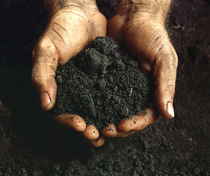Alabama Symbols
Alabama State Soil
Bama Soil Series

Adopted in April 22, 1997.
The Bama Soil Series was specified as the state soil of Alabama by the legislature in 1997. (Act no. 233)
The adoption of the Bama soil series as Alabama's state soil began in 1996 with the Professional Soil Classifiers Association of Alabama. The organization
adopted a Resolution to recommend the Bama soil series as Alabama's official soil. They were joined by the Alabama Soil and Water Conservation Committee
and the Alabama Association of Conservation Districts to urge the legislation that would name the Bama series as the official soil of the State with
the purpose to call attention to one of Alabama's most valuable natural resources. and it was hoped that this would increase awareness of the importance
of soil in the environment.
Alabama State Soil: Bama Soil Series

The official state
soil of Alabama is the Bama Soil Series. The Bama Soil Series includes fine-loamy, siliceous, subactive, and thermic Typic Paleudults and occurs throughout
the state. The Professional Soil Classifiers Association of Alabama adopted a resolution at its 1996 annual meeting recommending the Bama Soil Series
as the State Soil. The Association is composed of a group of soil classifiers representing the Alabama Cooperative Extension System, the Alabama Agricultural
Experiment Station, the USDA-Natural Resources Conservation Service, the Alabama A&M University, private soil consultants, the Board of Registration
for Professional Soil Classifiers, and the Alabama Department of Public Health. The Alabama Soil and Water Conservation Committee and the Alabama Association
of Conservation Districts also joined in recommending the Bama Soil Series as the official State Soil.
Source:
Acts of Alabama, April 24 1997
Bama soils are mainly in level to gently sloping areas on high terraces paralleling major river systems and on broad marine terraces. These very deep, well-drained, moderately permeable soils formed in thick deposits of loamy fluvial or marine sediments. The average annual precipitation is 56 to 64 inches. The average annual air temperature is 60 to 65 degrees F.
These soils make up more than 360,000 acres, mainly in the western and central parts of Alabama. They occur in 26 counties.
These soils are well suited to cultivated crops, pasture, hay, woodland, and most urban uses. Cotton and corn are the main cultivated crops. Some areas are used as woodland.
The Bama series was designated the official state soil of Alabama by the State Legislature on April 22, 1997.
Soil Profile
A typical Bama soil profile consists of a five inch topsoil of dark brown fine sandy loam; a six inch subsurface of fine sandy loam; and a red clay
loam and sandy clay loam subsoil to sixty inches or more.
The Bama soil is in the Ultisols soil order and is classified as fine-loamy, siliceous, subactive, thermic Typic Paleudults. Ultisols are old, highly
weathered soils developed under woodland vegetation. They are generally low in natural fertility. The term "fine-loamy" indicates that the
subsoil has between 18-35 percent clay with more than 15 percent sand. The term "siliceous" means that the sand and silt-size particles in
the upper part of the subsoil is more than 90 percent (by weight) silica minerals or other extremely durable minerals that are resistant to weathering.
The term "subactive" implies that the clay fraction in the upper part of the subsoil is dominantly low activity clays. "Thermic"
refers to an average annual soil temperature of between 15? and 22? C (59?-72? F).
Bama soils occur in 26 counties in Alabama. The Bama soils occur on more than 360,000 acres, mainly in the western and central part of the state, paralleling
major river systems. They formed in thick deposits of loamy fluvial or marine sediments. Bama soils are well drained, have desirable physical properties,
and are on high positions of the landscape, making them well suited for most agricultural and urban uses. They are well suited to cultivated crops,
pasture, hay, woodland, and most urban uses. Cotton and corn are the principal cultivated crops.
Taxonomic class: Fine-loamy, siliceous, subactive, thermic Typic Paleudults
Alabama Law
On April 22, 1997, the Alabama State Legislature approved Senate Joint Resolution No. 107 designating the Bama soil series the official state soil of Alabama. The Resolution was filed as Act No. 1997-233 on April 24, 1997.







